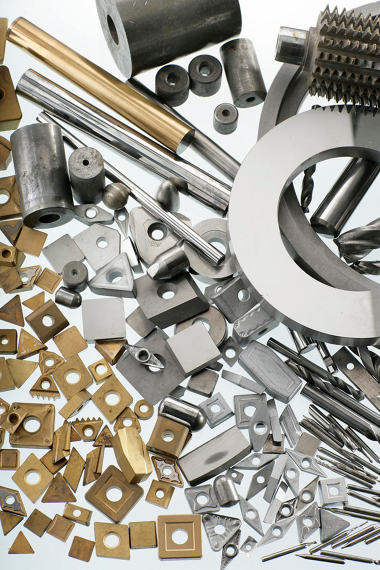CopperDigital – Data platform to increase efficiency, productivity and sustainability on copper alloy materials
18.10.2021The Fraunhofer Institute for Microstructure of Materials and Systems IMWS wants to provide a platform with data on copper alloy materials along the entire life cycle together with partners. The data, which is linked by means of ontologies, connects material characterization, alloy development, performance and service life through to recycling. This enables accelerated material development as well as the analysis of entire product cycles to make them both more sustainable and more productive - with full data sovereignty.
 The Fraunhofer IMWS wants to provide a platform with data on copper alloy materials along the entire life cycle together with partners
The Fraunhofer IMWS wants to provide a platform with data on copper alloy materials along the entire life cycle together with partners
© KupferDigital
With a consumption of around 28 million tons per year, copper is one of the world's most important materials. The metal is easy to process and also an ideal conductor of heat and electricity. It is therefore just as indispensable for most motors and generators as for numerous applications in electronics or communication technologies.
Digitization offers considerable opportunities for the development of new copper alloys, more efficient use of the metal and better recycling options. The Research Institute for Precious Metals and Metal Chemistry, the Fraunhofer Institute for Mechanics of Materials IWM, the Institute for Applied Computer Science e.V. (InfAI), the Helmholtz Institute Freiberg for Resource Technology (HIF), which is part of the Helmholtz Center Dresden-Rossendorf (HZDR), the Federal Institute for Materials Research and Testing (BAM), the German Copper Institute (DKI) and the Fraunhofer IMWS want to tap into these opportunities within three years in the project.
The project partners are relying on publicly accessible ontologies, i.e. a formally ordered representation of data and the relationships existing between them, to describe research, production and process data in order to enable interaction between all the partners involved in a value chain. Exchanging data between partners in a machine-understandable way will significantly accelerate development cycles for new alloys and products, but also for defect detection. The copper ontology as a common public language enables all interested partners to express their relevant data in a way that is understandable for all and to participate in a common data space.
The "digital material twin" should take material, testing, production process, simulation and recycling data into account covering the entire life cycle of copper-based materials. Which mine did the ore come from? What process routes were used to produce the alloy? What is the application behavior in a particular electronic component? How high is the proportion of valuable materials in a product that can be recycled? The demonstrator platform developed in the project should be able to answer such and comparable questions.
"Building on existing approaches, we want to implement this holistic solution of a virtual material data space. Preconditions for the development of a suitable ontology and a powerful data ecosystem are a suitable structure of data and metadata as well as a systematization of the handling of hierarchical, process-dependent material data," says Thomas Hanke, who is in charge of the project in the group of ontology development at the Fraunhofer IMWS.
The institute in Halle (Saale) is working on the sub-project "Microstructure and Property Correlation" within the so called project "CopperDigital" and is contributing its expertise in systematic microstructure analysis, theoretical finite element modeling and mechanical and standard-compliant characterization of copper and copper alloys to the digital data space, for example, with high-resolution methods such as EBSD, XRD, XRM/XCT and transmission electron microscopy allowing mapping down to the nm range. This level of detail is essential: material structure at the atomic level can have a significant impact on subsequent application behavior, in terms of a material's performance as well as the occurrence of defects.
"We want to establish an in-depth physical analysis of the structure-property relationships of exemplary copper alloys and a well-grounded digital description of the investigation processes. The data and process descriptions obtained must then be transferred to the ontology development in suitable formats for a cross-scale workflow, so that data and protocols can be automatically transferred to the copper data ecosystem," Robert Klengel describes the objective of his subproject at the Fraunhofer IMWS. The challenge is to semantically link complex material data from different investigation methods consistently across several scales, for example, to develop suitable data transfer formats.
Data completeness, quality and sovereignty are of particular importance in the planned platform. "Previous approaches to digital twins in materials science often failed due to concerns about data sovereignty and fear of industrial espionage. We rely on decentralized databases that enable data sovereignty for industry partners within International Data Spaces as well as the option of sharing data with the scientific community," says Hanke. "This linking of research results with the process tracking and manufacturing content of industry partners is one of the major advantages of the project, from which all sectors can benefit," confirms Klengel.
The resulting data space can be used, for example, to simulate how new alloys behave over multiple scales and life stages, which promises to accelerate the development of new alloys with significantly different properties. The energy and raw material consumption of production processes can be optimized, and recycling sources and routes can be better evaluated. The approach can also be applied to other materials such as steel or aluminum. This also applies to the ontologies that describe microstructure investigation methods. These should be designed in a way that they can be easily integrated into other workflows or adapted for individual needs.





